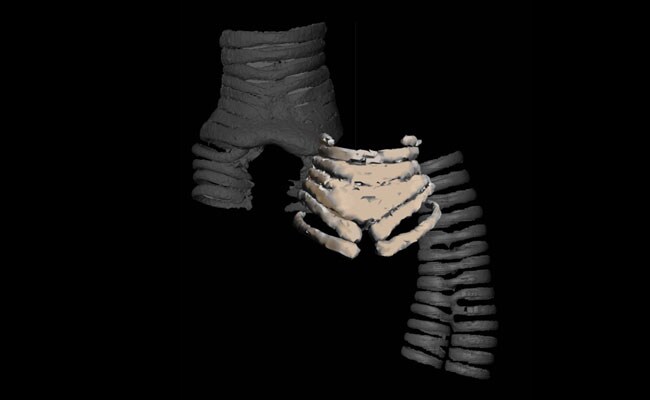
The fossil syrinx is from the late Cretaceous of Antarctica, during final act of age of dinosaurs. (AFP)
Paris:
Tyrannosaurus-rex and other dinosaurs woke up to birdsong just like we do, though it was probably more honk than melodic chirping, an extraordinary fossil find revealed Wednesday.
The discovery in Antarctica of the oldest known avian voice box -- called a syrinx -- proved that birds crisscrossed Late Cretaceous skies some 68 million years ago, during the final act of the age of dinosaurs, a study said.
Until now, the oldest known specimen of a syrinx -- made from cartilage quick to decompose -- dated from a mere 2.5 million years ago.
The new fossil belonged to a species known as Vegavis iaai and "shows an asymmetry seen in living ducks," said Julia Clarke, an associate professor at the University of Texas in Austin, and lead author of the study published in Nature.
 The structure of the syrinx suggested "the capacity to produce calls like honks or whistles," she told AFP.
The structure of the syrinx suggested "the capacity to produce calls like honks or whistles," she told AFP.
V iaai was already famous among paleontologists as the only true bird -- as opposed to a flying dinosaur -- known to have lived during the 186-million year Mesozoic Era.
There may have been others, yet to be discovered.
That epoch ended with a cataclysmic bang -- probably an asteroid impact which wiped out three-quarters of plant and animal life on Earth.
The Antarctica syrinx shows "that birds were calling to each other over the heads of dinosaurs," Clarke said.
It is one of a handful in the fossil record in which mineralised cartilage rings -- which support sound-producing soft tissue membranes -- have been identified.
The researchers were able to construct a 3-D model after scanning the specimen with a high-resolution X-ray imaging technique called microcomputed tomography.
To get a better idea of what kind of sounds the bird might have produced, they compared the model to a dozen types of present-day birds.
Conclusion: if it looks like a duck or goose, it probably quacks or honks like one too.
Today, there are over 10,000 species of modern birds almost everywhere on Earth.
The scientific consensus is that they evolved from a group of two-legged dinosaurs known as theropods, which included T. rex.
The discovery in Antarctica of the oldest known avian voice box -- called a syrinx -- proved that birds crisscrossed Late Cretaceous skies some 68 million years ago, during the final act of the age of dinosaurs, a study said.
Until now, the oldest known specimen of a syrinx -- made from cartilage quick to decompose -- dated from a mere 2.5 million years ago.
The new fossil belonged to a species known as Vegavis iaai and "shows an asymmetry seen in living ducks," said Julia Clarke, an associate professor at the University of Texas in Austin, and lead author of the study published in Nature.

Discovery of oldest known avian voice box proved birds crisscrossed Late Cretaceous skies.
V iaai was already famous among paleontologists as the only true bird -- as opposed to a flying dinosaur -- known to have lived during the 186-million year Mesozoic Era.
There may have been others, yet to be discovered.
That epoch ended with a cataclysmic bang -- probably an asteroid impact which wiped out three-quarters of plant and animal life on Earth.
The Antarctica syrinx shows "that birds were calling to each other over the heads of dinosaurs," Clarke said.
It is one of a handful in the fossil record in which mineralised cartilage rings -- which support sound-producing soft tissue membranes -- have been identified.
The researchers were able to construct a 3-D model after scanning the specimen with a high-resolution X-ray imaging technique called microcomputed tomography.
To get a better idea of what kind of sounds the bird might have produced, they compared the model to a dozen types of present-day birds.
Conclusion: if it looks like a duck or goose, it probably quacks or honks like one too.
Today, there are over 10,000 species of modern birds almost everywhere on Earth.
The scientific consensus is that they evolved from a group of two-legged dinosaurs known as theropods, which included T. rex.
Track Latest News Live on NDTV.com and get news updates from India and around the world

